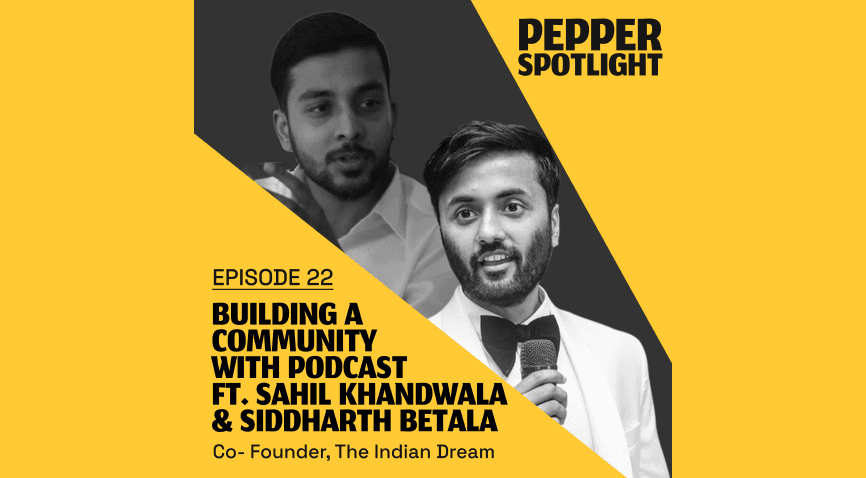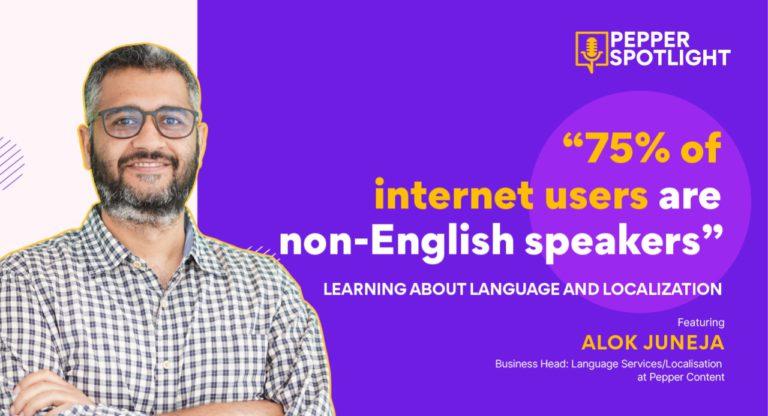Building a Community with Podcast ft. Sahil Khandwala & Siddharth Betala | Pepper Spotlight Ep. 22

Envision this scenario: An idea strikes your mind one ideal Sunday afternoon. You romanticize the idea in your head for a few days and then lose wind of the concept. This habit sounds like most people we know.
However, Sahil Khandwal and Siddharth Betala decided to turn ideas into actions every step of the way. The duo hosts “The Indian Dream [TID],” a podcast about entrepreneurship, startups, and the creator market.
While this might look like just a podcast on the surface, they have managed to grow it into a community. The duo shared incredible insights and learnings from this journey on Pepper Spotlight, our weekly podcast for creators.
We have summaries of some of the key takeaways from the show. However, if you want to absorb the essence of these conversations truly; check out the link below for the whole episode:
Chasing An Ideas
A fascinating part about the origin of the TID is that both Sahil and Siddharth started the podcast as strangers. The stars aligned one day when they reconnected on LinkedIn after being acquainted in college.
They soon landed on the idea of starting a podcast, and it took off with zero friction. They believe that not being friends when the show started added a sense of accountability. But chasing an idea is not as easy as they make it look.
They explain the secret to this lack of procrastination is “Bias towards action.” The duo is a firm believer in doing things without overthinking. “Just do anything that comes to mind,” says Sahil.
“We split the work between tech and content; then set ourselves a deadline to meet the goal,” Siddharth added.
Video Podcast Vs. Audio-Only
The choice between a video or audio podcast has bothered many creators. But for the folks at TID, this decision was simple.
“When you are a hammer, everything looks like a nail,” said Sahil. Both the creators of TID are avid podcasts listeners. This personal trait drew them closer to chasing an audio format for the show.
They also noticed many shows on the startup and brand-building ecosystem, but not many cater to the Indian audience. They believe that stories about homegrown companies and founders can create a lasting impact.
The main reason for non-video was the fact that audio editing is easier and faster than video editing. They were looking to build a product and send it out to the world. And nitpicking on video concepts was only going to hold them back. “Also, see our faces!” Sahil said jokingly.
In their own words: The audio medium was an easier learning curve, and video seems much more challenging to them.
The Bargain of Discoverability
If given a choice to go back in time and re-do the podcast, they would possibly have attempted the same as a video series. The TID hosts admit that the visible drawbacks of being audio-only only pinch you in the video-dominated world.
A platform like Youtube is beneficial when building a podcast brand from scratch. Everyone’s youtube feed looks different and presented with work they will often consume.
A podcast feed drives on static charts and pages that do not change by the listener’s interest. The best way to reach more people is by hitting a “top 10” list.
However, podcast retention is much higher. A loyal listener of a podcast will come back and revisit all your episodes and stay updated with every new publication. “The top of the funnel is small, but the connection with the audience is much stronger,” explains Siddharth.
Building A Community With Podcasting
Some of us might have heard of the concept of “1000 true fans”. A theory that suggests a creator needs 1000 loyal fans to make any endeavor successful. Lee Gen, however, started a fund about the passion economy that suggests you need only 100 superfans.
Building a loyal community is a slow and painstaking process. But building a paying community is a further uphill battle, according to the duo. “I don’t do it, so I don’t force anyone to do it,” said Siddharth to explain paid subscriptions in India.
“We decided that getting Indians to pay is not gonna be easy,” they add. Telling someone that content is low-quality and you will need to pay to unlock higher returns is not a model that India takes seriously.
This roadblock encouraged them to turn TID into a brand rather than a stand-alone podcast. People already pay for many communities, and TID is on its way to building something more around it.
They started as a podcast and soon realized there is a lot more you can do with content. Now they have newsletters and Whatsapp groups that receive a curated list of weekly content.
Abhinav Shikara, of 10K designers, once said: “Email does not work in India. Since you are part of spam.” This insight was the reason the duo decided to build a Whatsapp community. “We did not think it would become ten groups, but it did,” they said. “These are admin-only groups, and we ensure there is no spam.”
An Insight About The Internet
Here is something interesting about the duo behind TID — the two of them do not use Instagram! While they do use social media from a business point-of-view, they personally believe social media is nothing but a series of “FOMO.”
Sahil explains his obsession with photos, captions, etc. “I was not living in the moment, but rather based on the validation [I will get] for it later,” he adds.
According to them, 22-23 years olds have built their lives on the internet. And these age groups will always know how to use the internet the right way. For Gen-Z, this boom is a blessing.
However, people who are today of the age of 27+ are not internet natives, and they believe they will always be a step behind in making the correct use of the web.
In Closing,
This duo recently struck a deal with Gaana, the music streaming platform, for an original podcast series. This show followed after the roaring success of TID.
“The Gaana deal was more thought through,” they said. They reached out to a bunch of podcast players and managed all the work to get it live. They created a new show for Gaana, as opposed to selling the IP for TID.
The story of this duo is nothing short of fascinating. They made their debut as guests on another podcast with us on Pepper Spotlight. If the work done by TID or the idea of community building sounds fascinating to you — check out the whole episode today.
Latest Blogs
Explore how Google’s 2025 AI search updates triggered ranking chaos. Learn actionable strategies to adapt your SEO for AI Overviews, zero-click searches, and SERP volatility. Stay ahead now.
Learn how to rank on AI search engines like ChatGPT, Perplexity, and Gemini by optimizing your content for authority, structure, and relevance. Stay ahead in AI-driven search with this strategic guide.
Explore the best healthcare SEO services for your medical practice. Improve online visibility and effectively reach more patients in need of your services.
Get your hands on the latest news!
Similar Posts

Pepper SPOTLIGHT
3 mins read
Learning About Language and Localization Podcast with Alok Juneja: Pepper Spotlight

Content
7 mins read
What Marie Kondo Can Teach You About Writing Better

Email Marketing
8 mins read